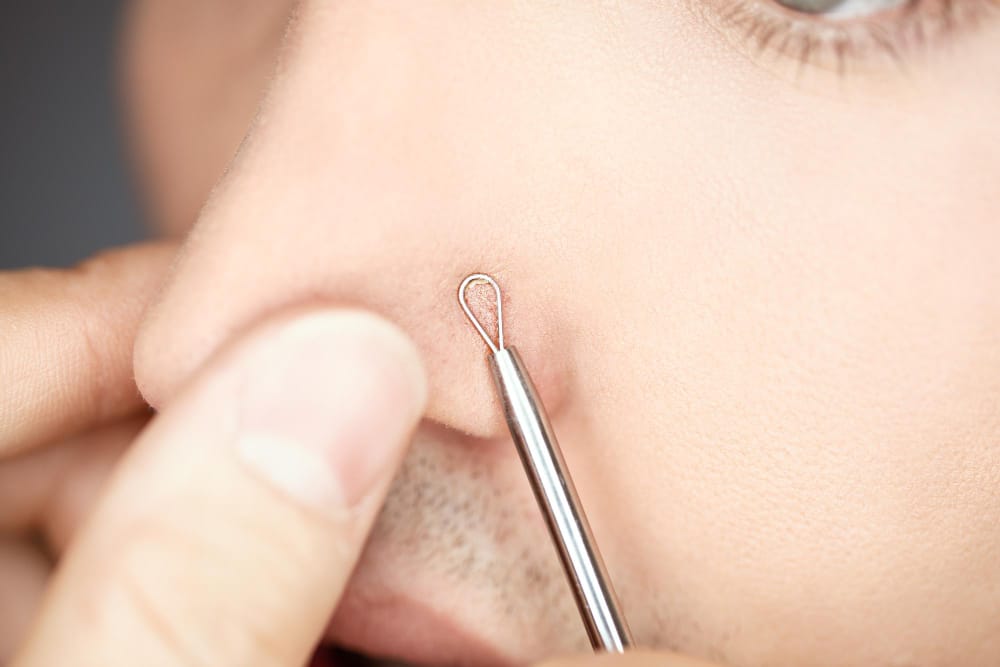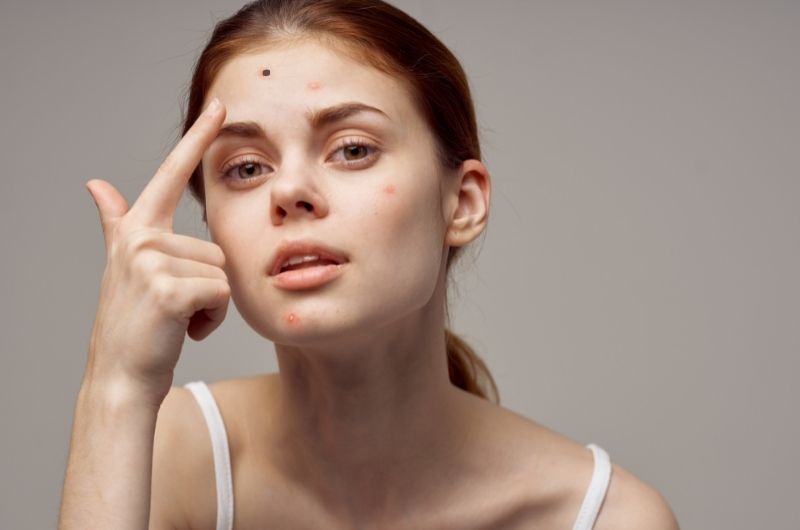A black seed-like thing on your skin could be a giant blackhead or a dilated pore of Winer. It’s just a collection of a lot of sebum and other debris on your clogged pore, which became black because it was exposed to air. It could also be an epidermoid or sebaceous cyst. You can remove the “black seed” using tweezers but let a professional do it if it’s really large. To prevent infection, don’t touch or pop a dilated pore or a skin cyst. Washing and exfoliating your face with facial cleansers that contain alpha and beta hydroxy acids, applying retinoids, using facial masks, and doing chemical peels, may help unclog your skin pores and keep your skin healthy.
I came from a family that suffers from acne. Thankfully, I don’t suffer from acne breakouts on my face; they happen to be at my back! I think that’s okay because they’re usually covered. But it’s still a skin condition I couldn’t deny.
I once popped out a black sesame seed-like thing near my belly button. At first, I thought, “Oh, my god! I squeezed out my mole!”
When I examined it, there was white stuff on its end, and “the seed” was easily cut in half by my fingernail. It also left a “crater” to where I popped it out.
I had no idea what it was. And, It freaked me a little because who doesn’t freak out when they randomly discover a black seed-like thing on their skin? After researching online, I came up with three things that could have been the black seed I popped out on my belly button.
Giant blackheads
Larger than normal-sized blackheads are known as giant blackheads or giant comedones.
They may appear as single blackheads on your forehead, chin, neck, chest, or torso. The sizes of giant blackheads range from several millimeters to two centimeters (0.78 inches) in diameter.
They would look like a black sesame seed lodged in a tiny “crater” or the pore opening of your skin. (Like what I had on my belly button!).
Giant blackheads are often harmless and shouldn’t be much of a concern, just a major eyesore on your skin!
When removed, the “seed” could either be soft if your skin is hydrated or hard if it’s dry.
Causes of giant blackheads
Like a regular-sized blackhead, giant blackheads are just keratin and sebum that collects on your clogged hair follicle (pore) opening.
The reason behind your clogged pore is the accumulation of dead skin cells. When exposed to air, the contents inside the pore turn to black color (oxidizes).
It increases in size (dilate) when the pore remains clogged and collects keratin and sebum. That’s why a really, really large blackhead is also commonly known as Dilated pore of Winer (DPOW).
Although doctors don’t know the direct cause of a giant blackhead or a dilated pore, it mainly occurs in people who have a history of severe acne and/or cystic acne.
Other contributing factors may include the following:
- Increased body oil (sebum) production that could result from hormonal changes during puberty, menstrual cycle, and/or when taking birth control pills.
- Size of hair follicles or pore opening
- Sun damage or exposure to ultraviolet rays
- Older age means more extended exposure to the sun and loss of skin elasticity
- Use of comedogenic products and drugs like corticosteroids, lithium, or androgens
- Unregular shedding of dead skin cells that may irritate your hair follicles
- Severe acne due to the buildup of Propionibacterium acnes bacteria on the skin
Though doctors can’t clearly explain the connection between your diet, acne, and blackhead production, eating dairy and food products high in sugar and carbohydrates may trigger your breakout.
How to treat and remove giant blackheads
1. Use tweezers and comedone extractor

Though a giant blackhead shouldn’t be a severe problem, it can indeed turn into one, especially when it solitarily sits on your forehead or wherever part of your skin is easily spotted.
If it doesn’t cause you pain or any discomfort, just annoying and embarrassing, it’s pretty easy to remove using tweezers and a comedone extractor.
But, this might be tricky to do at home, so you probably have to see a skin pro or a dermatologist to have it extracted.
Remember that it’s better to keep your hands off it, and don’t ever try to pick a giant blackhead or a dilated pore to reduce the risk of infection.
2. Excision surgery
While using tweezers and a comedone extractor can effectively clean the contents on your pore, surgery is the most effective method in completely removing a dilated pore of Winer while reducing its chances of coming back.
For a larger dilated pore, your doctor will have to completely remove the pore’s contents by cutting (excise) the skin and walls around it.
You will first receive a local anesthetic before your doctor performs a cut during the surgery. Then, they will apply pressure to squeeze the pore and remove its contents using tweezers.
Once the procedure is completed, your doctor will stitch close the pore opening.
Treating infected dilated pore of Winer
Giant blackheads are not a threat to your health, but let a professional handle them to prevent infection if you decide to have them removed.
When signs of infection occur, such as redness, swelling, and pus oozing out on the pore, make sure to clean the area and treat it with antibiotic ointment or prescribed oral medications.
Remember, it’s essential to follow any post-surgical care methods given by your doctor, such as keeping the area clean and dry to prevent any complications.
If things go smoothly, you’ll most likely have your stitches removed after 10 days. Call your doctor immediately when signs of infection, bleeding, and scarring occur after surgery.
How to prevent getting gigantic blackheads?
Because experts don’t know the exact cause of giant blackheads, the following preventive measures may or may not be effective for you.
However, preventing acne breakouts, such as reducing your risk of clogged pores, may help.
Below are what you can do to prevent clogged pores:
1. Wash your skin daily using a gentle facial cleanser and exfoliating agents
Use salicylic acid and glycolic acid products to cleanse and exfoliate your skin from excess oil, dead skin cells, and dirt. Both products are the most common and prominent alpha and beta hydroxy acids (AHAs and BHAs), which offer excellent skin health benefits.
2. Use topical acne treatments
Using retinoids may help unplug clogged pores or boost the effectiveness of other OTC products on your skin.
Salicylic acid may also help by drying out and exfoliating dead skin cells. But, it’s essential to avoid these products if you have a dry skin type.
If you’ve been using benzoyl peroxide for your blackheads, it may not do you any good as it doesn’t treat all types of acne and can only be effective with cysts and pustules or removing the bacteria of a pimple.
3. Use only non-comedogenic products
When shopping for skincare products, make sure only to buy oil-free and non-comedogenic makeup, lotions, and sunscreens to lessen your risk of clogged pores and avoid your blackheads from multiplying.
4. Add clay or charcoal mask to your skincare routine
Using a clay or charcoal mask once a week after your exfoliating treatment may help unclog your pores by drawing out oils and toxins from your skin.
5. Try chemical peels
Using chemicals peels is a great way to fight signs of aging on your skin. It also effectively removes and prevents clogged pores by getting rid of your dead skin cells.
Epidermoid cyst
If you notice a small, dome-shaped, movable bump filled with thick, yellowish to white material and a tiny “blackhead” plugged on its opening, it could be an epidermoid cyst.
Though the name itself sounds disturbing, it is actually a common type of skin (cutaneous) cyst which is often non-cancerous (benign).
It comes in many different terms: follicular infundibular cysts, epidermal cysts, epidermal inclusion cysts, or keratin cysts.
It is also mistakenly referred to as sebaceous cysts.
Epidermoid cysts don’t involve or grow in the sebaceous gland; instead, it is the buildup of keratin on the upper portion of the follicle found in your epidermis or develops on the surface just below your skin.
Below are some possible causes of epidermoid cyst:
1. Trauma or injury to the skin
Your skin produces a natural protein called keratin which, can be trapped if an injury or trauma causes a surface or part of it to be implanted underneath. It could be due to a scratch, surgical wound, or acne.
2. Underlying genetic disorders
These include the following:
- Gardner Syndrome (Familial Colorectal Polyposis)
- Gorlin Syndrome (Basal Cell Nevus Syndrome)
- Favre-Racouchot syndrome
How to treat epidermoid cyst
Though the cyst may look tempting to pop, you shouldn’t pick or touch it as it may become irritated and inflamed.
Epidermoid cysts are typically harmless and would shrink in size then grow again. Many never get their cysts treated, but treatments are necessary when signs of infection or inflammation occur.
Your healthcare provider may need to give you the following treatments:
- Injection of steroid medicine to reduce inflammation
- Antibiotics to treat infection
- Incision of the cyst wherein your doctor will drain a thick, yellowish, smelly material through the small opening and have it temporarily removed
- Surgical excision to completely removed the cyst and prevent it from coming back
Sebaceous cyst
This type of cutaneous cyst is less common and occurs when the glands that produce your bodily oil are damaged or its duct is blocked.
Trauma can cause it to the skin or an underlying genetic disorder such as Gardner’s syndrome or basal cell nevus syndrome.
Sebaceous cysts are generally painless and harmless, just like an epidermoid cyst. You may choose to have it completely removed through surgery to prevent the cyst from coming back.
It’s also essential that you follow post-surgical care methods given by your doctor to avoid scarring and infection. The sebaceous cyst may develop malignantly (cancerous) in very rare cases.
If the following signs occur, please visit your doctor immediately and get a diagnosis.
- Signs of infection such as mild to severe redness, pain, or pus drainage
- An abnormally larger-sized cyst which is much larger than 5 centimeters or
- The cyst quickly comes back after removal
Takeaway
Giant blackheads and skin cysts may appear if you’re prone to having clogged pores. These may look like black seed-like things on your skin.
The “seed” may be hard to touch if you have dry skin. Otherwise, your fingernail can easily crush it.
Always wash your face with non-comedogenic facial cleansers and exfoliate using products with alpha and beta hydroxy acids (AHAs and BHAs). Promoting your skin health by applying topical acne treatments like retinoids, using clay or charcoal masks, and doing chemical peels may effectively unclog your pores, reducing your chances of getting giant blackheads or skin cysts.
If infection occurs, visit a skin doctor immediately. You may need to take antibiotics or have the black seed-like thing on your skin removed.


